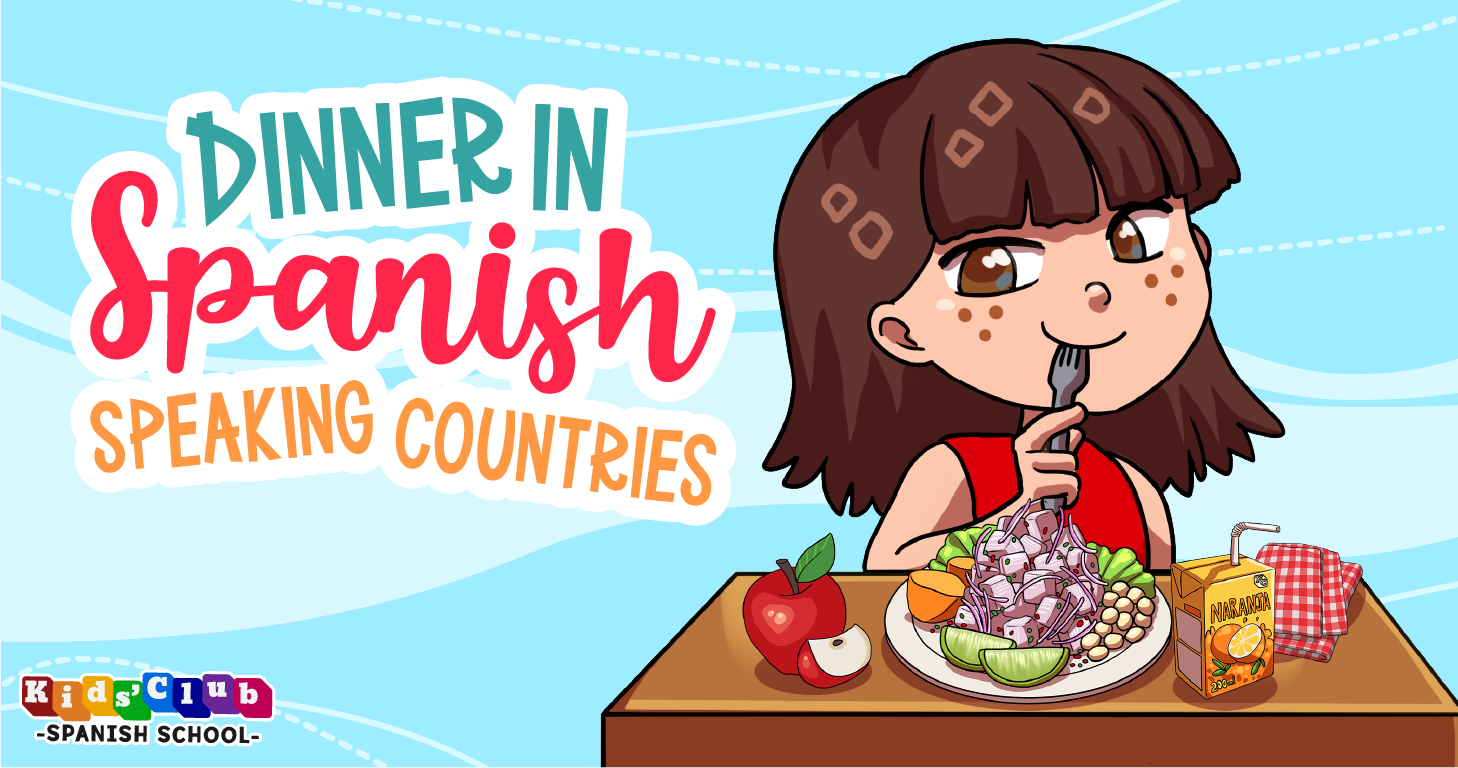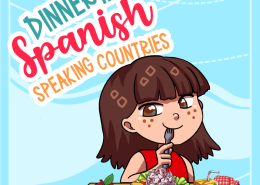Dinner in Spanish Speaking Countries: A Culinary Tour
Alexis K Fishbaugh – April 26, 2024


Alexis K Fishbaugh – April 26, 2024
This blog dives into the customary dinner dishes across 21 Spanish-speaking nations, detailing their key ingredients and preparation methods, thus highlighting the rich diversity of dinner in Spanish cuisine. We’ve handpicked the top two dinner dishes from each country, as favored by our Spanish teachers who represent the diverse nationalities in question, to truly capture the culinary essence of their homelands. To streamline your culinary journey, the countries are listed in alphabetical order. And here’s a little surprise: did you know there’s a country in Africa where Spanish is the official language?
Asado, the quintessential Argentine barbecue, involves grilling various cuts of meat over an open fire. The preparation starts with seasoning the meat with salt before slow-cooking it on a grill, known as a ‘parrilla,’ or a fire pit. Accompaniments often include chimichurri sauce—a mix of herbs, garlic, vinegar, and oil.
Milanesa consists of thinly sliced beef, chicken, or sometimes eggplant, breaded and fried. The meat is dipped in beaten eggs, coated with breadcrumbs, and fried until golden. It’s commonly served with mashed potatoes or a simple salad.
Silpancho features a layer of rice and boiled potatoes topped with a thin breaded beef cutlet, fried eggs, and pico de gallo (tomato, onion, and jalapeño salad). The beef is seasoned, breaded with breadcrumbs, and fried until crisp.
A hearty meal, Pique a lo macho consists of chunks of beef, sausages, onions, and locoto (Bolivian hot pepper), stir-fried and served over fries, topped with boiled eggs and tomatoes. It’s known for its spicy kick and substantial portion size.
Pastel de choclo, a corn pie, combines ground meat (usually beef), chicken, onions, olives, hard-boiled eggs, and raisins, topped with a layer of mashed corn. It is baked until the corn crust is slightly browned.
Cazuela is a simple yet nourishing soup made with beef or chicken, corn, potatoes, pumpkin, and rice, cooked slowly until the flavors meld. It is seasoned with garlic, cilantro, and other spices to enhance its comforting taste.

“Asado, the quintessential Argentine barbecue, involves grilling various cuts of meat over an open fire.”
Bandeja Paisa typically includes rice, red beans cooked with pork, fried egg, plantain, chorizo, arepa (corn cake), and avocado. It is a filling meal that combines flavors from various ingredients cooked separately and served together.
Ajiaco is a chicken soup made distinctive with three varieties of potatoes and the Galinsoga parviflora herb, known locally as ‘guasca.’ It is served with corn, capers, cream, and avocado, adding richness and complexity to the dish.
Gallo Pinto is a mixture of rice and beans with onions, sweet peppers, and cilantro. It’s often served with sour cream or a scrambled or fried egg on top. The key is to sauté the rice and beans in a pan after boiling to enhance their flavors.
Casado, translating to “married man,” includes rice, beans, plantains, salad, and a choice of meat, typically grilled chicken, fish, or meat with onions. It reflects the everyday meal of Costa Rican families, balancing nutrition and taste.
Ropa Vieja, made with shredded beef stewed in a tomato-based sauce with bell peppers, onions, and spices, is a flavorful dish that translates to “old clothes” for its appearance. It is typically served with rice and sometimes black beans.
Picadillo, a hash made with ground beef, tomatoes, raisins, olives, and capers, Picadillo is a sweet and savory dish often served with white rice. It can also include potatoes or be stuffed into pastries.
Encebollado, is a fish stew from Ecuador made with fresh tuna, yuca, and seasoned with pickled onions and tomatoes. It’s known for its tangy and refreshing flavor and is often accompanied by corn on the cob and plantains.
Llapingachos, are potato pancakes stuffed with cheese and cooked until golden brown. They are typically served with a peanut sauce, sausages, or a simple salad. The outside is crispy, while the inside remains soft and gooey from the cheese.
Pupusas are thick corn tortillas stuffed with a blend of cheese, beans, or pork. They are grilled until the exterior is crispy. Pupusas are served with curtido, a spicy cabbage slaw that complements their richness.
Sopa de Gallina. This chicken soup is made with hen, vegetables, and herbs, simmered slowly to create a rich broth.It’s seasoned with coriander, mint, and served either warm or chilled, often as a rejuvenating dish for the soul and body.
“Bandeja Paisa typically includes rice, red beans cooked with pork, fried egg, plantain, chorizo, arepa (corn cake), and avocado.”

Tortilla Española, a beloved Spanish omelette made from a simple blend of potatoes, eggs, and onions. Often served as a tapa, it can be enjoyed hot or cold, making it a versatile dish for any meal.
Paella, a well-known Spanish dish, Paella combines rice, saffron, various meats (like chicken, rabbit, or duck), and seafood (such as shrimp and mussels) cooked in a large pan. Vegetables like peas and peppers add color and freshness to this vibrant and communal dish.
Pepian is a thick, rich stew made from roasted spices, tomatoes, and meat—typically chicken, pork, or beef. It’s served with rice or tortillas and garnished with fresh cilantro, offering a deep, smoky flavor.
Kak’ik, a traditional Mayan turkey soup, Kak’ik is colored with achiote and spiced with coriander, cloves, and cinnamon. It comes with rice, tortillas, and sometimes a side of tamalitos (mini tamales).
Succotash, a hearty dish made with lima beans, corn, and sometimes additional vegetables or meat. It’s a fusion of native ingredients, reflecting the blend of African and Spanish culinary traditions.
Pepper Soup. A spicy, invigorating soup made with beef, chicken, or fish, generously seasoned with hot peppers and native spices, often enjoyed to break the evening fast or as a warm-up during the rainy season.
Baleadas. A simple yet delicious Honduran dish, Baleadas are flour tortillas filled with refried beans, cheese, and often additions like scrambled eggs or avocado. It’s a common dinner option that’s both filling and versatile.
Pollo con Tajadas. Fried chicken served with fried plantain slices and cabbage salad, topped with pickled onions and hot sauce. It’s a mix of sweet, savory, and spicy flavors that epitomize Honduran street food.
Tacos in Mexico are typically served in the evening, especially the soft corn variety filled with a range of ingredients from grilled meats to sautéed vegetables, garnished with onions, cilantro, and a squeeze of lime juice.
Enchiladas. Corn tortillas rolled around a filling—usually shredded chicken, beef, or cheese—then covered in a chili sauce. Enchiladas are baked and often topped with more cheese, sour cream, and sliced onions.
Gallo Pinto. Similar to Costa Rica, this staple made from rice and beans is a common dinner in Nicaragua, often served with meat or a fried egg on top.
Quesillo. Soft tortillas filled with mozzarella-like cheese, onions, and cream. Quesillo is a street food favorite often enjoyed in the evening as a quick and satisfying meal.
Sancocho. A Panamanian chicken soup richly infused with herbs, especially cilantro, and mixed with vegetables such as yuca and plantains. It’s known for its restorative properties and is a beloved dinner staple.
Arroz con Pollo. A hearty dish of rice and chicken, seasoned with a sofrito of bell peppers, onions, and garlic, mixed with peas and carrots. It’s a colorful and comforting dish typical of family dinners in Panama.
Sopa Paraguaya. Despite its name, Sopa Paraguaya is a solid cornbread made with cornmeal, cheese, and onions. It is a traditional food often served with a stew or asado (barbecue).
Chipa Guasu. Similar to Sopa Paraguaya but made with fresh corn, Chipa Guasu is more like a corn pie, including eggs, cheese, and sometimes onions. It’s a typical accompaniment to various meat dishes at dinner.
Lomo Saltado. A stir-fry dish that combines marinated strips of sirloin with onions, tomatoes, and fries, typically served with rice. Lomo Saltado is a perfect example of the Chinese influence on Peruvian cuisine.
Ceviche. Typically enjoyed as a light dinner or appetizer, Peruvian ceviche is made with raw fish cured in citrus juices, spiced with chili peppers, and accompanied by sides of sweet potato, corn, and lettuce.
Mofongo is a delightful combination of mashed plantains, garlic, and pork cracklings, often filled with shrimp, chicken, or beef. This dish is a reflection of Puerto Rico’s rich cultural heritage, combining Taino, African, and Spanish influences.
Arroz con Gandules is a quintessential Puerto Rican dish consisting of rice cooked with pigeon peas, pork, olives, capers, and seasoning. It’s flavorful and hearty, often served during celebrations and family gatherings.
La Bandera, translating to “The Flag,” is a traditional Dominican meal representing the colors of the flag with white rice, red beans, and stewed meat, usually chicken or beef, alongside fried plantains.
Sancocho is a rich and hearty stew made with a variety of meats, typically including chicken, pork, and beef, cooked with vegetables, corn, and root vegetables in a savory broth, symbolizing a mix of indigenous and Spanish culinary traditions.
Chivito is a national sandwich in Uruguay consisting of a thin slice of filet mignon, with mozzarella, tomatoes, mayonnaise, and often bacon, eggs, and ham. It’s a popular quick dinner option.
Asado. Similar to Argentina, Uruguayan asado involves a barbecue of various meats, including beef ribs and sausages, cooked over an open fire. It’s a social meal that gathers family and friends.
Arepas are a staple in Venezuelan cuisine. These cornmeal cakes are grilled or fried and then filled with a variety of ingredients, such as cheese, meats, or black beans. Arepas are versatile and widely consumed for dinner.
Pabellón Criollo is considered the national dish of Venezuela, consisting of shredded beef, black beans, and rice, accompanied by fried plantains, symbolizing the union of the country’s diverse cultural influences.
The culinary journey through dinner traditions in Spanish-speaking countries has been a flavorful expedition, revealing the intricate tapestry of the region’s gastronomic heritage. From the hearty embrace of an Argentine asado to the zesty allure of Peruvian ceviche, each recipe narrates a saga that mirrors the land’s history, terrain, and the vivaciousness of its inhabitants. These dishes serve as culinary ambassadors, not just quelling appetites but knitting together communities, honoring ancestral legacies, and extending the warmth of familiarity.
In much the same way, Kids’ Club Spanish School endeavors to enrich young minds by offering two free online Spanish classes that are as engaging and diverse as the culinary delights we’ve explored.
Sign your kids today at www.kidsclubspanishschool.com for two free trial Spanish lessons. They will experience our immersive Spanish program’s teaching and possibilities.
 Kids' Club Spanish School, LLC
https://kidsclubspanishschool.com/wp-content/uploads/2024/07/blog_summer-spanish-activities-for-kids-3.png
807
800
Alexis Fishbaugh
https://cdnwp.kidsclubspanishschool.com/wp-content/uploads/2025/05/kids-club-spanish-school-header-logo.webp
Alexis Fishbaugh2024-07-28 22:48:532024-07-28 22:48:53Summer Spanish Activities for Kids
Kids' Club Spanish School, LLC
https://kidsclubspanishschool.com/wp-content/uploads/2024/07/blog_summer-spanish-activities-for-kids-3.png
807
800
Alexis Fishbaugh
https://cdnwp.kidsclubspanishschool.com/wp-content/uploads/2025/05/kids-club-spanish-school-header-logo.webp
Alexis Fishbaugh2024-07-28 22:48:532024-07-28 22:48:53Summer Spanish Activities for Kids Kids' Club Spanish School, LLC
https://kidsclubspanishschool.com/wp-content/uploads/2024/05/blog-spanish-bugs-fun-facts-engaging-activities-101.webp
800
800
Alexis Fishbaugh
https://cdnwp.kidsclubspanishschool.com/wp-content/uploads/2025/05/kids-club-spanish-school-header-logo.webp
Alexis Fishbaugh2024-05-26 18:28:052024-07-21 05:53:07Spanish Bugs: Fun Facts and Engaging Activities
Kids' Club Spanish School, LLC
https://kidsclubspanishschool.com/wp-content/uploads/2024/05/blog-spanish-bugs-fun-facts-engaging-activities-101.webp
800
800
Alexis Fishbaugh
https://cdnwp.kidsclubspanishschool.com/wp-content/uploads/2025/05/kids-club-spanish-school-header-logo.webp
Alexis Fishbaugh2024-05-26 18:28:052024-07-21 05:53:07Spanish Bugs: Fun Facts and Engaging Activities Kids' Club Spanish School, SL
https://kidsclubspanishschool.com/wp-content/uploads/2024/04/dinner-in-spanish-speaking-countries.png
800
800
Alexis Fishbaugh
https://cdnwp.kidsclubspanishschool.com/wp-content/uploads/2025/05/kids-club-spanish-school-header-logo.webp
Alexis Fishbaugh2024-04-25 12:22:352024-07-21 05:40:48Dinner in Spanish Speaking Countries
Kids' Club Spanish School, SL
https://kidsclubspanishschool.com/wp-content/uploads/2024/04/dinner-in-spanish-speaking-countries.png
800
800
Alexis Fishbaugh
https://cdnwp.kidsclubspanishschool.com/wp-content/uploads/2025/05/kids-club-spanish-school-header-logo.webp
Alexis Fishbaugh2024-04-25 12:22:352024-07-21 05:40:48Dinner in Spanish Speaking Countries Kids' Club Spanish School, LLC
https://kidsclubspanishschool.com/wp-content/uploads/2024/03/free-online-spanish-for-beginners-squared-ad.png
800
800
Alexis Fishbaugh
https://cdnwp.kidsclubspanishschool.com/wp-content/uploads/2025/05/kids-club-spanish-school-header-logo.webp
Alexis Fishbaugh2024-03-29 13:09:202024-05-01 14:54:20Free Online Spanish Classes for Beginners
Kids' Club Spanish School, LLC
https://kidsclubspanishschool.com/wp-content/uploads/2024/03/free-online-spanish-for-beginners-squared-ad.png
800
800
Alexis Fishbaugh
https://cdnwp.kidsclubspanishschool.com/wp-content/uploads/2025/05/kids-club-spanish-school-header-logo.webp
Alexis Fishbaugh2024-03-29 13:09:202024-05-01 14:54:20Free Online Spanish Classes for BeginnersClick here to add your own text

Join the fun and come learn Spanish online with us! Native certified teachers making learning Spanish certifiably fun

 Kids' Club Spanish School, LLC
Kids' Club Spanish School, LLC Kids' Club Spanish School, LLCSpanish Bugs: Fun Facts and Engaging Activities
Kids' Club Spanish School, LLCSpanish Bugs: Fun Facts and Engaging Activities